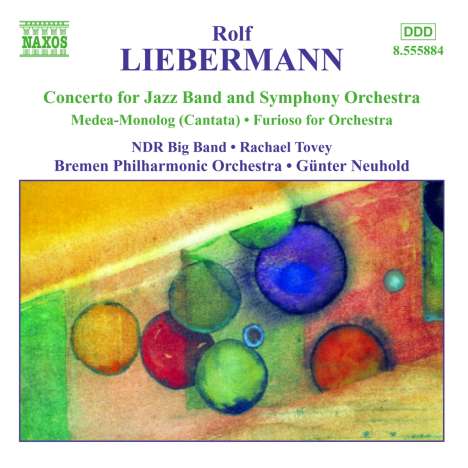Rolf Liebermann: Konzert für Jazzband & Orchester auf CD
Konzert für Jazzband & Orchester
Herkömmliche CD, die mit allen CD-Playern und Computerlaufwerken, aber auch mit den meisten SACD- oder Multiplayern abspielbar ist.
Lassen Sie sich über unseren eCourier benachrichtigen, falls das Produkt bestellt werden kann.
+Furioso for Orchestra; Geigy Festival Concerto; Kantate "Medea-Monolog" für Chor & Orchester; Symphonie "Les Echanges"
- Künstler:
- Rachael Tovey, Alfons Grieder, Konzertchor Darmstadt, Bremer Philharmoniker, NDR Bigband, Günter Neuhold
- Label:
- Naxos
- Aufnahmejahr ca.:
- 2001
- UPC/EAN:
- 0747313588428
- Erscheinungstermin:
- 10.12.2002
Ähnliche Artikel
"Warum sollte es nicht erlaubt sein, in der Form des italienischen concerto grosso, in dem eine Gruppe von Solisten einem vollen Orchester gegenübergestellt wird, ein Werk zu arrangieren, das Jazzsolisten und ein Sinfonieorchester kontrastiert und kombiniert?" fragte sich Rolf Liebermann, als er in einem Kompositionsauftrag für den Südwestrundfunk Baden-Baden sein Werk für das Rundfunk-Sinfonieorchester und das Jazz-Ensemble von Kurt Edelhagen schrieb, das am 17. Oktober 1954 in Donaueschingen uraufgeführt wurde. "Mein Konzert muss der Versuch sein, ein Element des aktuellen zeitgenössischen Tanzes in die Kunstmusik einzubringen" - das Problem, die beiden Musikgruppen miteinander zu verbinden, löste Liebermann auf amüsante Weise: "Das Jazzorchester wird als Äquivalent zum vorklassischen Concertino eingesetzt, während das Sinfonieorchester die Funktion der Begleitung und des Zwischenspiels übernimmt". Das Konzert besteht aus acht Sätzen, die abwechselnd vom Orchester und der Jazzband gespielt und durch eine Zwölftonreihe zusammengeführt werden.
Das Streichertremolo und kurze Blechbläsermotive in der Einleitung sorgen für eine fast impressionistische Atmosphäre - dies ist die Domäne eines Symphonieorchesters, und die anderen "symphonischen" Teile, Scherzo I, Scherzo II und Interludium, bieten charakteristische klassische und romantische Sätze. In den Jazzsätzen gibt es drei Tänze. Der Jump steht im Swing-Rhythmus; die sinnliche Stimmung eines Blues erscheint, umrahmt von den beiden Scherzi, als langsamer Satz des Konzerts. Boogie-Woogie ist eine Hommage an einen Stil, der in den ersten Jahrzehnten des zwanzigsten Jahrhunderts von den farbigen Musikern aus Chicago eingeführt wurde. Im Mambo kommen beide Welten schließlich in einem spannenden Abschluss zusammen.
Product Information
‘Why should it not be permissible to arrange, in the form of the Italian concerto grosso, in which a group of soloists is set against a full orchestra, a work that contrasts and combines jazz soloists and a symphony orchestra?’ Rolf Liebermann asked himself, when, in a commission for South West Radio Baden-Baden, he wrote his work for the radio symphony orchestra and Kurt Edelhagen’s jazz ensemble, first performed on 17th October 1954 at Donaueschingen. ‘My concerto must be an attempt to include an element of actual contemporary dance in art music’ - the problem of how to be able to combine the two musical groups was amusingly solved by Liebermann: ‘The jazz orchestra will be used as the equivalent of the preclassical concertino, while the symphony orchestra takes on the function of accompanying and providing intervening episodes’. The concerto is in eight movements, played in alternation by the orchestra and the jazz band, brought together by the use of a twelve-note row.
The string tremolo and short brass motifs in the Introduction provide an almost impressionistic atmosphere — this is the domain of a symphony orchestra, and the other ‘symphonic’ parts, Scherzo I, Scherzo II and Interludium, offer characteristic classical and romantic movements. In the jazz movements there are three dances. Jump is in swing rhythm; the sensuous mood of a Blues appears, framed by the two Scherzos, as the slow movement of the concerto. Boogie-Woogie is a homage to a style that was introduced in the first decades of the twentieth century from the coloured musicians of Chicago. In the Mambo finally both worlds come together in an exciting conclusion.
Rezensionen
P. Steder in Audio 10/03: "Als sein "sensationellstes" Werk bezeichneten Kritiker Rolf Liebermanns Opus nach der Premiere 1954. Meist unter Klassik abgelegt, ist es am spannendsten stets dann, wenn die in Zwölfton-Technik komponierten "klassischen" Teile durch jazzige Tänze wie Jump, Blues oder Boogie-Woogie abgelöst werden, die ganz schlicht "Introduktion" oder "Interludium" heißen; dies zeigt, wie Liebermann die Akzente setzte. Der von NDR Big Band und Bremer Philharmonie hingelegte Mambo ist umwerfend."Disk 1 von 1 (CD)
-
1 Furioso for Orchestra
-
2 Geigy Festival Concerto
-
3 Medea-Monolog (Cantata)
-
4 Les Echanges (Symphonie)
-
5 Concerto for Jazz Band and Orchestra: Introduction
-
6 Concerto for Jazz Band and Orchestra: Jump
-
7 Concerto for Jazz Band and Orchestra: Scherzo I
-
8 Concerto for Jazz Band and Orchestra: Blues
-
9 Concerto for Jazz Band and Orchestra: Scherzo II
-
10 Concerto for Jazz Band and Orchestra: Boogie-Woogie
-
11 Concerto for Jazz Band and Orchestra: Interludium
-
12 Concerto for Jazz Band and Orchestra: Mambo








